-
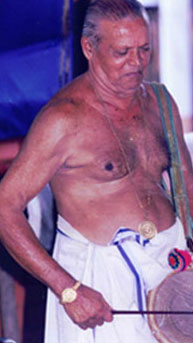 Pallavur Appu Marar
Pallavur Appu Marar -
 Pallavur Kunjukuttan Marar
Pallavur Kunjukuttan Marar -
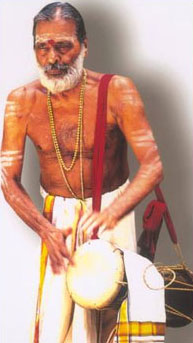 Kuzhur Narayanan Marar
Kuzhur Narayanan Marar -
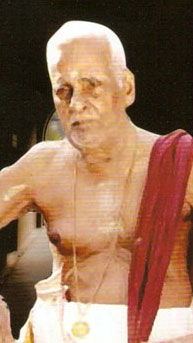 Chakkamkulam Appu Marar
Chakkamkulam Appu Marar -
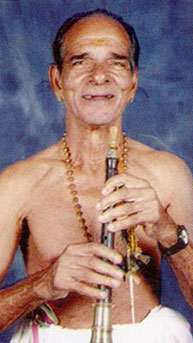 Kombath Kuttan Panikkar
Kombath Kuttan Panikkar -
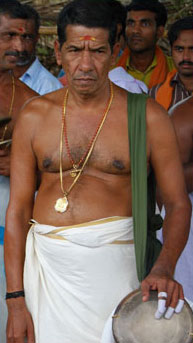 Annamanada Parameswara Marar
Annamanada Parameswara Marar -
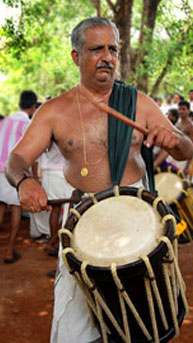 Peruvanam Kuttan Marar
Peruvanam Kuttan Marar -
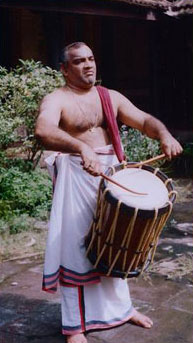 Mattannur Sankarankutty Marar
Mattannur Sankarankutty Marar -
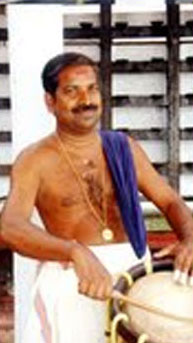 Peruvanam Satheeshan Marar
Peruvanam Satheeshan Marar -
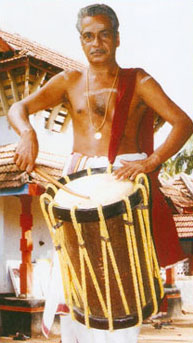 Kizhakkoottu Aniyan Marar
Kizhakkoottu Aniyan Marar -
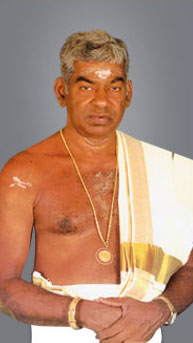 Kummath Ramankutti Nair
Kummath Ramankutti Nair -
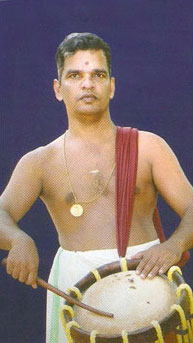 Cherussery Kuttan Marar
Cherussery Kuttan Marar
Latest News
Vadhya Kala
Written Like a Travel Guide
The theoretical knowledge will not help to understand and enjoy this complicated art form. The performing art of Kerala is a combination of mathematics and classical music. This is the total symphony of the different sounds produced by entirely different type of instruments, strictly following raga & thala. So it should be approached delicately as watching an oil painting. Keep a distance, or you will be disturbed by the patches of the brush. The variations in "surthy" from various instruments will be multifold in a closer scrutiny.
Few Tips
Thalam: Technically thalam is the division of time.
Thalavattam: is the prescribed time (Say speed) to complete the cycle.
Kalam: The variation in speed to complete the assigned job.
Aksharakalam: To understand the structure of thalam, the time should be defined and it is aksharakalam. (nearly one second) The concept "Thalam" is believed to be "God given" through "Vedas" as retold by "Rishies" (Saints). Lord Siva is always carrying a musical instrument called "Damaru" which can be equated to modern "Chenda", "Madhalam" "Thimila" and "Edakka". The former instruments can easily produce the Premier word of Hinduism "Aum" while the Edakka can pronounce vocal music. In a music concert or in a dance the roles played by instruments are complementary or supplementary but in talavadyangal they are independent.
The artists: Most of the practicing artists in this field are from Marar/Poduval families, a division of Hindu Nair community. Carrying the instrument in one shoulder and the compensation in the form of paddy in a gunny bag in the other shoulder was the picture of theses artists of late forties. Now the scenario has changed and the artists are well rewarded in all respect. Taught and practiced by "Guru Kula style" each and every artist have a status which is strictly followed by virtue of the artists talent, skill, and interpretation and not by age.
The Conductor: The senior most artist in Pramanvadhya( Leading instrument) the conductor of the ensemble. Pramani as the conductor is called will communicate through his body language only. The artist in the right side will receive the instruction from the chief and convey to next artist in the right side in the same manner. The same procedure will follow in the left side also. The chief will supervise the whole performance periodically by turning left, right and to back.
Panchavadyam
This is a most popular art form in Kerala. Panchavadyam has undergone drastic changes-revolutionary, adorable-during last 80 years in every respect.
Instruments: Thimila, Madhalam, Edakka, Kombu, Elathalam & Sanghu.
Pramanvadhya (Leading instrument): Thimila.
The Arrangements: The no of artists varies from 12 to 54 or 55 depending on various factors like duration, place, type etc. The proportion is to every Madhalam, there should be double + one "Thimila" and for every Thimila there should be equal nos of "Kombu" & "Elathalam". One "Edakka" is essential. For larger no: of artists the no: of "Edakka" may vary from 2 to 3. The grouping of the artists and hierarchy is strictly followed
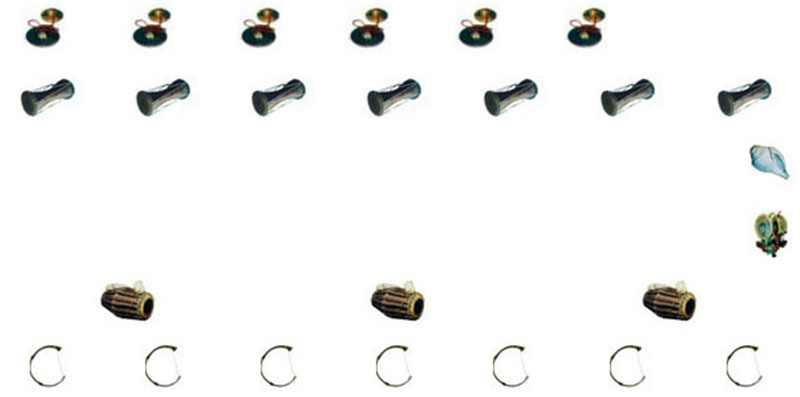
Order: The chief of each instrument will stand in the center and the next one in the right side third one in the left. "Edakka" will be stationed at right-hand side of the "Madhalam" If there is second "Edakka" it will be positioned at left hand side. "Sanghu" will be at right hand side of the right Edakka.
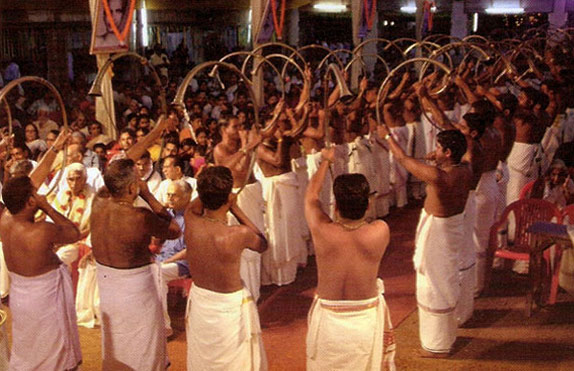
The vadhyam: The ensemble starts with "Sanghu" which produces the sound "AUM" twice and on 3/4th way through the third "AUM" "Thimila" and other instruments except "Kombu" reproduces the same "AUM". Pyramidal in its rhythmic structure the Panchavadyam is divided in 10 "kalams" Starting from 896 "aksharakalam" as 1st "kalam" ending at 1¾ "aksharakalam" as the 10th "kalam" is the format of "panchavadhyam". However theses 10 "Kalams" are grouped to 3 as Slow or "Pathikala" 1,2&3 "Madhya" (intermittence kalam) with 4,5&6 and "Drutha kala" - Speedy kala - with 7,8,9&10. It will take 14 to 15 minutes to complete first kalam. Here the chief will decide from which kalam the ensemble should start. The criteria is the duration allowed. Long vadhyas will start from 1st kalam or 2nd and short from 3rd or 4th. Even though the talam followed is adantha the influence of chempda will be there up to last few "Kalams". Starting from the slow, and lengthy paces the vadhyam reaches to short, speedy "thripuda" (the thrilling pace of the ensemble) and ends in an explosion of sound. To end this shower of sound there is an exciting piece of art called "Thimila Edachil". Performed in Chempada thalam by few Thimilas and supported by elathalams it is an excellent mixture of skill, speed and sound.
Maestros in the field (Past & Present-not in order)
Annamanada Parmeswara Marar & Peethabhara Marar, Thiruvillamala Venkideswara Ayer(Venkichen Swamy), Punnathur Madhavan Nair, Pallavoor Maniyan, PattararathSankaramarar, Machad Nanu Nair, Kuzoor Narayana Marar, Kadavalloor Aravindakshan, Chottanikkara Narayanan & Vijayan, Kalamandalam Parameswaran, Thrikkur Rajan, Parakkat Thankappan etc.
Chenda Melangal
Chenda Melangal: is the most popular and widely acclaimed keshtra vadhyas of Kerala. More than 300 years old melam is an integral part of all festivals in Kerala irrespective of cast or religion. The most important among these melams are "Pandy" (Splendid & Majestic) and "Panchari" (sweet & pleasing) which may extent up to 5 hours. The leading instrument is "Chenda", Kerala's own instrument. The Chenda is divided into "Valamthala Chenda & Edamthala Chenda" (right & left side of the instrument) or "Veekam Chenda" & "Uruttu Chenda". The covering is soft in Edamthala but in layers in Valamthala.
Chenda can produce multiple vadhyas the "Devavadya" using "Valamthala" and Asura vadhyas through "Edamthala". With infinite range & magnificent sound "Chenda" is above all 18 instruments.
Chempada Melangal
Chempada Melangal: Generally there are 7 types of melangal viz: Panchari, Champa, Chempada, Adantha, Anchadatha, Druvam and Pandy. The earlier 6 melams are called "Chempada melangal" and they are one way or other closely associated and the model is the premier one "Panchari". Of all "Pandy" stands distinctive. Two more melams, "Navam" & "Kalpam" were developed by a Maestro in the field Sri Kumarapuram Appu marar.
There are few artists to perform all these melangal at an equal ease with total dedication, interpretation, meditation, skill & talent.
Some of the past and present are : Pallavoor Appu Marar, Thripekulam Achuta marar, Chakkumkulam Appu Marar, Kachamkurichikannan, Kelath Aravindakshan, Pervanam Kuttan, Mattannur Sankarankutty (with out any prejudice or order)
Instruments: Chenda, Kurumkuzal, Kombu, Elathalam.
Pramanavadhya (Leading instrument): Uruttu Chenda
Role of each instrument in general:
"Uruttu Chenda" - To lead the orchestra.
"Veekam Chenda" - to keep the thalam
"Elathalam" - To support the Veekam Chenda
"Kombu & Kuramkuzal" To keep the orchestra with in the prescribed limits and to blend & balance.
The melangal are performed in a tight format without any compromise and each and every instruments has equally important role to perform and the conductor will see that all are in tune &time with one another.
The no: of Artists: Kurumkuzal & Kombu may be in equal numbers with "Uruttu Chanda", Elathalam must be in double and "Veekam Chenda" should be triple the numbers of "Uruttu Chenda". The ratio of "Veekam" to "Uruttu" may be 1:6 for magnificence.
The Arrangement
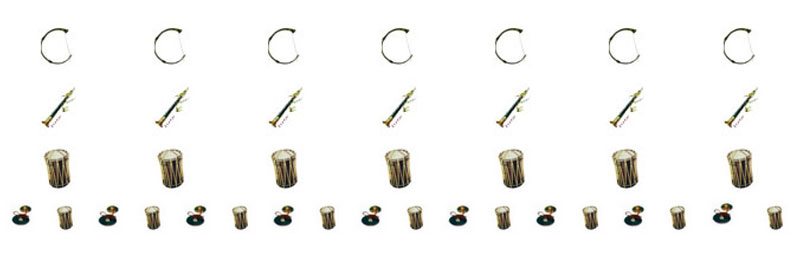
The positions are arranged such way that to have a direct interaction between the artists. "Kurumkuzal" is holding the wand supported by the "Kombu" so both these artists must have direct Eye contact with the Leader.
Common features: All these Chendamelangal have common Features like same instruments are used, positions and duties are same. Performed in ever increasing tempo and the proportionally decreasing number of beats in the cycle. The role of the "Pramani" and the hierarchy are identical in vadhayam & melam.
Panchari
Panchari: Performing on Chenda with one stick and hand (R&L) is the simple identification of this form. Divided into 3 steps in 5 "Kalams" the concert starts at 96 "aksharakalam" and ends at 6 "aksharakalam". The 3 steps are classified through the mode of using the stick. The first one "Nerkol" (slow) is beating directly perpendicular to the surface of Chenda. On to second step both beats are in swinging mode with a slight inclination. The second stage is called "Thakkida" (Normal)and third as "Kuzamarinja" kalam (Fast) step. The wrist of the hand will fully rotate in the third. "Kalamidal" (take off) is the foundation of Panchari and the blue print will be ready after the "12th chempada vattam" ("Aksharakalam" divided by 8 is one chempada vattam). The melam starts (airborne) at the second part of Vilambakalam (pathikalam) - called Varthikam. The melam smoothly travels to 2nd , 3rd 4th & 5th Kalam ( in 6,3,1½,¾ - chempada vattams) and completes in "Theerukalasam". The 5th kalam is entirely different & more jubila. Listening to "Panchari" the melam with an eminence is like watching the Tidal waves from shore.
Thalam: Chempada till 5th Kalam, Panchari in 5th again chempada in "Theerukalasam" Ragam : Sankarabharanam.
Pandi
Pandi: Clearly perceptible, widely acclaimed, "pandimelam" attained towering heights due to its performance in "Elajitharamelam" of Paramekkavu in Thrissur pooram. The pandimelam is distinct from other Chenda melamgal. The fundamental change is the use of stick in both hands. Pandi is like climbing a stair case. No. Of Steps + Landing again No. Of Steps + Landing and finally at the top of the tower (explosion of sound) The "takeoff" is in an entirely different format called "Kolumbal/Koottiperukkal" which is an enchanting experience. It is difficult to confine "Pandy" to "kalam" or "Aksharakalam". The pandy is designed in such a way that it is accelerating step by step very systematically. During the course of time it will cover up the kalams, not strictly time - bound. The beauty of Pandy is its "Kalasams". Normally after 4 Thalavattam "Kalasam" is performed in 3 to 6 thalavattams (Subject to the speed of the melam). kalasa thalavattangal is done through "Nerkol" which shows the nobility and depth of the Pandi. The speed and no of beats are directly proportional. 100 and odd Chendas in "Nerkol" complemented by another 50 and odd instruments- the grand finale of "PANDYMELAM" - is a thrilling experience.
Thalam: ADANTHA Ragam : BHAIRAVI
Some maestros in the field - Chenda (without prejudice/ order) Peruvanam Narayana marar, Thrippekkulam Govinda marar, Peruvanam Appumarar, Thrippekulam Achuthamarar, Pallavoor Appumarar, Chakkumkulam Appumarar, Pervanam Kuttanmarar, Mattannur Sankarankutty marar, Peruvanam Satheesan Marar, Cherussery Pandarthil Kuttan Marar
Thayambaka
Thayambaka: This is another illustrative art form in Vadhyakala and more or less a one man show. Supported by "Elathalam" the thayambaka is performed in "Chenda". Classified as a temple art "Thayambhaka" is staged in between the "deeparadhana" and "athazapooja" Of the temple ( just after the wee hours of the day). The venue is after the "Valiya balikallu" & before the "Balivattom".
The duration is 1¼ hour which may vary from ½ an hour to 1½ hour It is a thrilling experience to watch a "Thayambhaka". In front of the holy lamp the supporting artists are lined leaving the center space for the Maestro, as
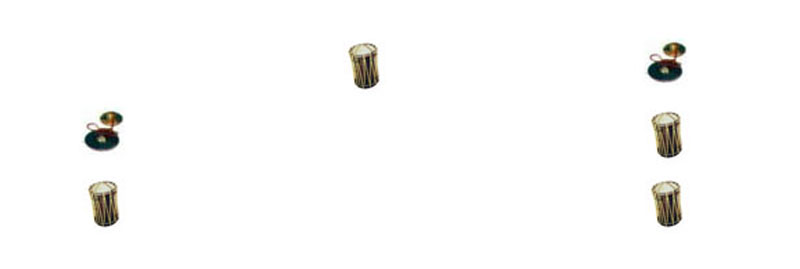
The program starts with a typical style "Kottivekkuka" by "Valamthala" Chenda, supported by "Elatahalam". Starting from "Thripuda" and turning to "Ekathala" (eka means one) the melam enters the last phase of the preface of "thayambaka". Here enter the master of the ensemble and positions at the center and beats twice and the concert starts. From "Pathikalam" (slow pace - Chempadavattom) "Thyambhaka" steadily travels though various steps like "Kooru" "Edavattom" 1st stage & 2nd stage," "Edanila" & "Erikida". Here the "Thayambhaka" ends with a shower of downfall. Single/double/ triple/ penta "Thayambhaka" - According to the no. of "Pramanies". The no: of "valamthala & Elathalam" may be increased but the "Edamthala" remains on two.
Some masters & their way of handling "thayambhaka"
Aliparambhu Sivarama Poduval - systematic & pure
Kallur Ramankutty Marar - Vibrant
Mattannur Sankarankutty Marar - Sweet and classic
Porur Unnikrishnan - Explosive.
Pallavoor Appumarar & Kunjukuttan Marar, Pookattiri Divakara Poduval, Thrithala Kunjukrishna Poduval & Kesava Poduval are some of the masters in this field with proven track record.
Valiyapani
Valiyapani: Instruments used are SANGHU, CHENGILA, ELATHALAM, KOMBU, KUZHAL, Chenda & maram. There are two type of pani - big and small. Valiya pani is again divided into saivapani & vyshnavapani. The earlier is nearly extinct and latter is used during festivals only.
In a nut shell: Advaita Vedanta is considered as the culmination of rational thinking in India. The absolute of this philosophy can be represented by the syllable "Aum". This is also known as "Pranava". The real point of this pranava lies in the fourth state which is termed as "Turiya" - the measureless one (amantra). It may be pointed out that these forms of Kerala vadhyangal somehow accommodate this philosophy. Mathematically multiplying odd no. with even no. is "Panchavadyam & Pandimelam (7*2=14). And with even no. with even no is "Panchari (6*2=12). The melam which uses hand & stick-may be considered as "Swathika" (Bramanya) and using both sticks the "Pandy melam" as rajaswa(Kshatriya) combination of these "Swathika" & rajaswa is "Pancha vadhyam". The gist of all these is "Thayambaka". One who mastered in "Thayambaka" can perform any talavadyangal.
